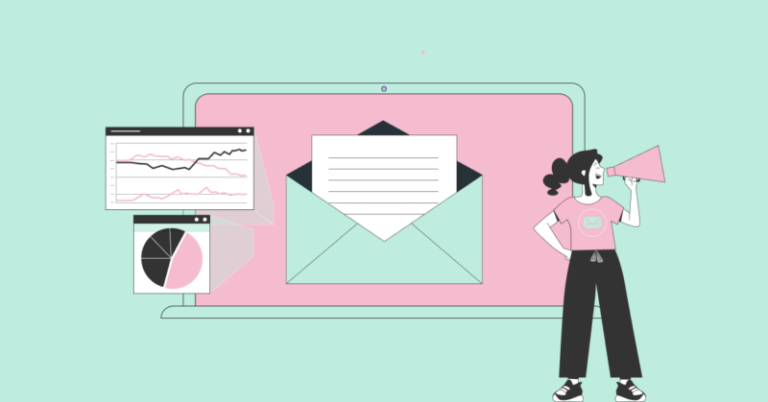The B2B industry is quite different from other sectors. One of the biggest differences is that the buyer’s journey is typically longer. B2B buyers will read multiple content pieces before they’re ready to make a purchase. As such, B2B businesses need to nurture their target audience more.
Email marketing can be a very effective way to share various types of content pieces and nurture subscribers. Plus, as the B2B industry has come to realize that it’s time to focus less on in-person and virtual events and more on digital forms of marketing, like email, the next few years will be critical for your email marketing campaigns.
To help you craft an effective B2B email marketing strategy, here are over 20 valuable stats to keep in mind. And, to make sure you realize just how big email marketing is, we first start off with a couple of general email marketing statistics before exploring how it applies to B2B organizations and their marketing teams.
Top 23 B2B Email Marketing Statistics You Need to Know in 2023:
23 B2B Email Marketing Stats
1. There will be nearly 5 billion email users by 2025
According to information shared by Statista, it’s anticipated that there will be about 4.6 billion email users in 2025. To put this growth into better perspective, in 2020, the number of email users across the world was estimated at 4 billion.
2. More than 370 billion emails will be sent per day by 2025
In 2020, Statista reported that more or less 306 billion emails were sent (and received) each day across the world. This number is expected to increase by more than 70 billion in the next few years to exceed 376 billion daily emails by 2025.
In 2023, the number of emails sent and received each day across the world is estimated to add up to 347.3 billion already. It will then continue to increase slowly just like it has done since 2017.
3. Email marketing revenue is set to reach nearly $14 billion by 2025
Since 2020, email marketing revenue has increased steadily. It’s anticipated that by 2025 it will reach $13.69 billion. To put this growth into perspective, in 2020, it was merely $7.5 billion.
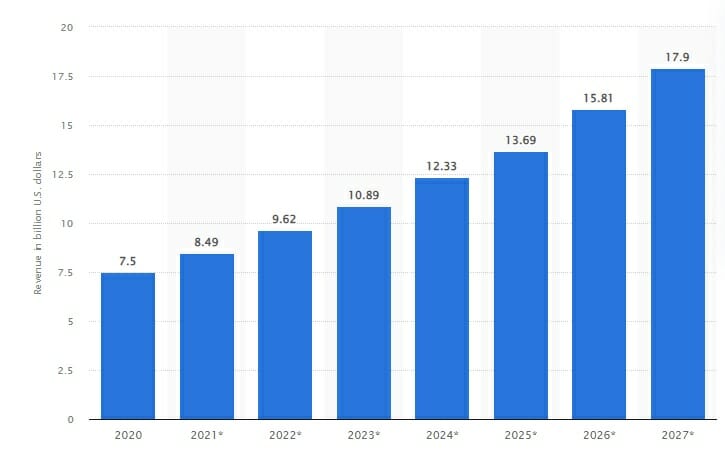

Source: statista.com
4. Consumers typically have more than one email account
According to an email statistics report shared by The Radicati Group, a technology market research firm, consumer email accounts drive the most growth. They estimated that in 2022, the email accounts per user ratio were 1.86 accounts per user.
The reason for this is that some consumers prefer to have separate email accounts for different purposes. For example, they’ll have a dedicated email account just for shopping, and another one for social interactions.
5. 80% of the US population used email in 2022
Data shared by eMarketer predicted that by 2022, about 80% of the US population would use email by 2022. That said, the opinions and sentiments about email among US users aren’t too great.
A survey completed at the beginning of 2022 that gathered US users’ opinions of emails revealed that nearly 60% felt that most emails that they received were useless, while more than half felt that they received too many emails (yet only 20% described them as too distracting).
Less than a third enjoyed checking their emails.
6. The average email deliverability rate is just below 85%
A recent blog post published by Email Tool Tester found that the average deliverability for all email tools combined was just below 85%. The other 15% of the emails sent were either flagged by spam filters or vanished into the abyss.
7. Most B2B companies have an in-house marketing team
In the US, more than half of B2B companies (56%) have a dedicated, in-house marketing team. The hybrid approach was also popular, with nearly 40% completing some marketing activities in-house and outsourcing others. Only 6% outsourced all their marketing activity.
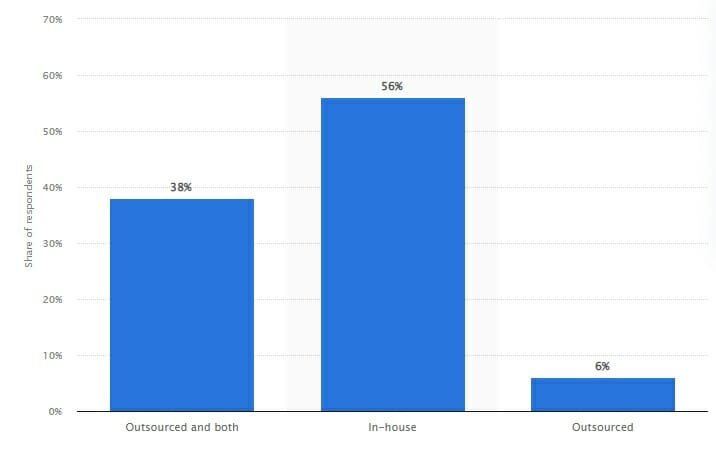

Source: statista.com
8. The majority of US B2B companies allocate only 5% to marketing
What might come as a shock is that most B2B companies in the United States don’t spend a lot on marketing activities. About a third allocated only 5% of their budgets to marketing activities. What’s more, about 23% dedicated only 1% or less.
On the opposite end of the spectrum, 26% allocated 15% or more of the budget to marketing efforts.
9. B2B businesses spending more on digital than traditional marketing
A survey completed at the beginning of 2022 has revealed that digital marketing spending was going to receive the biggest boost. B2B businesses that focused on products revealed that they planned to increase their digital marketing spending by more than 13% compared to the previous 12 months. To put this increase into better perspective, B2B marketers planned to increase their traditional ad spending by less than 1%.
What makes this statistic so significant isn’t necessarily the huge percentage difference. Businesses that operate in the B2B space have for a long time made traditional ad formats their main focus. However, as there’s a much greater demand for digital, it leaves B2B brands with no choice but to follow suit and adapt. So, the real significance of this stat is that it serves as proof that the B2B industry as a whole is heading into a new direction when it comes to advertising.
While this change from traditional to digital has already started a number of years ago, the pandemic has certainly increased the speed at which this shift took place. As a matter of fact, since 2018 B2B digital ad spending in the United States has doubled.
That said, email marketing won’t get a big slice of the pie. Only 18% have identified email marketing as a top priority in terms of spending. Social media marketing, branding, content marketing, and website development will all receive more money than email marketing, according to Sagefrog’s 2022 B2B Marketing Mix Report.
10. Fewer B2B marketers have a content marketing strategy in place
While emails might be shorter than your typical long-form blog post, it still forms an integral part of content marketing. Yet, a survey completed in the middle of 2022 has revealed that only 40% of B2B marketers have admitted that they have a documented content marketing strategy in place.
11. 75% of B2B organizations use email marketing software to help with content marketing
The B2B Content Marketing Benchmarks, Budgets, and Trends: Insights for 2022 report, released by the Content Marketing Institute in partnership with MarketingProfs and ON24, found that 75% of B2B organizations use email marketing software to help with their content marketing efforts.
Overall, it’s the third most popular technology. The most popular technology is analytics tools like web analytics (83%), followed by social media publishing or analytics tools (80%).
To give you an idea of just how big their marketing technology stack is, a survey completed among B2B marketers in US, UK, and Canada revealed that 44% use 5-10 tools. Only 6% use more than 20 tools.
However, the majority of B2B marketers at mid-market and enterprise companies are overwhelmed by their MarTech stack, finding it too complex. In fact, nearly 1 out 5 described it as “more complex than a black hole”. The solution for 42% is to reduce it to fewer solutions, according to research shared by Anteriad, a full-funnel B2B marketing solutions provider, and Ascend2, a provider of B2B research.
12. HubSpot is one of the most popular tools
According to Sagefrog’s 2022 B2B Marketing Mix Report, nearly half have identified HubSpot as their most popular marketing automation platform. Other popular email marketing automation tools among B2B names include ActiveCampaign and Oracle.
13. 69% of B2B organizations use email newsletters
After their organization’s website and blog (which is actually also part of the website), email is the most popular owned-media platform for content distribution. Nearly 70% of B2B organizations used their email newsletter to distribute content in the past year.
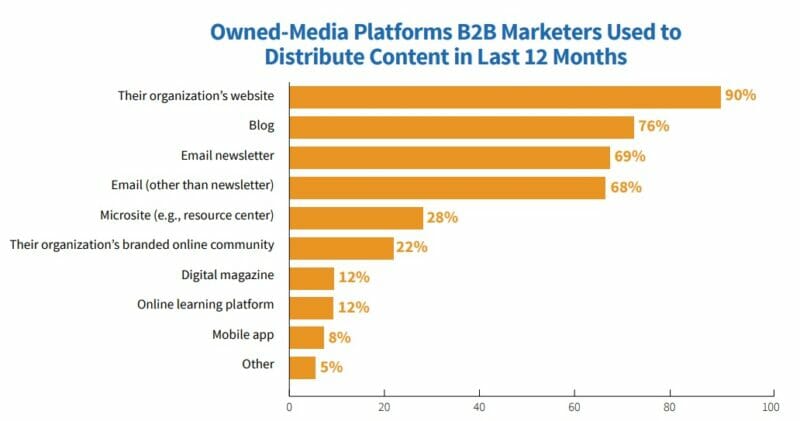

Source: contentmarketinginstitute.com
General emails are just as popular with 68% of B2B marketers indicating that they use emails other than newsletters for this task.
14. Marketing personalization is as important as social media marketing
B2B marketers located in the US have identified that social media marketing and marketing personalization are equally important. This channel and strategy were what they planned to make their main marketing tactics to be implemented in 2022.
Some of the best practices for B2B email marketing that you can use to personalize your approach are:
- Segment your mailing list according to different types of B2B buyers
- Consider the different stages of the buyer’s journey when planning your email marketing campaigns
- Include the recipient’s name in the subject line (alternatively, you can use second-person pronouns like “you” and “your”)
15. Most B2B buyers are comfortable with brand purchase history to be used
In order to incorporate marketing personalization, you need to have access to your subscribers’ data, though. Of late, data collection has received a lot of attention and with the right reason.
A survey completed in 2022 found that 82% of B2B buyers believe that it’s appropriate for marketers to collect their brand purchase history. Info on their important life events was another example of data that most B2B buyers are fine with being collected.
16. 31% of B2B marketers use partner emails
Of the B2B organizations that use paid content distribution channels, less than a third indicate that their marketing teams use partner emails to market their content. To put this into better perspective, more than double use social media advertising (with LinkedIn and Facebook being the most popular channels) and search engine marketing (SEM).
17. Email engagement is seen as the most valuable metric for 64% of B2B organizations
The good news is that the vast majority of B2B organizations measure how their content performs. Of the 75% that measure content performance, 64% of organizations feel that measuring email engagement has given them the most insights during the past year.


Source: contentmarketinginstitute.com
What’s interesting to note here, though, is that while more than double preferred to use social media channels for paid content, only 51% found social media analytics to be the most insightful.
18. A third find email subscriber numbers more valuable than email engagement
While email engagement is the clear winner in terms of metrics used by B2B businesses, 32% find that measuring email subscriber numbers has given them more insight. With regards to the cost to acquire a new subscriber, only 26% feel that this is the most valuable metric.
19. Nearly half feel they’ve successfully nurtured their subscribers
Nearly half of B2B marketers (49%) feel that they’ve managed to nurture subscribers in the last 12 months with the help of content marketing. On the other hand, only 37% feel that content has helped them to build a subscribed audience.
20. Messaging is a major struggle
Messaging is foundational to email marketing campaigns, which makes the following stat quite alarming. The vast majority of B2B marketing decision-makers feel that their messaging strategy is ineffective. Only 8% feel that it was very effective. On the other hand, more than 30% feel that it was in need of significant improvement, while about 15% described it as ineffective.
Some of the main communication challenges experienced by B2B marketing professionals in the United States are:
- Lacking knowledge about which digital marketing techniques would be more effective for driving growth
- Difficulty digitalizing the sales process
- Lacking the skills needed to create a strong buyer’s journey online
21. A third of B2B businesses will invest more in content distribution
While events and video are areas where most B2B brands indicated that they invested in 2022, 33% focused on investing in content distribution. While it doesn’t specify how much of that spending would be awarded to email, considering that most use email marketing software, it’s safe to say that email will feature.
Also, as communication is still a challenge for nearly 4 out of 10 B2B businesses, investing in email could be a smart choice, helping them to achieve two aims at once.
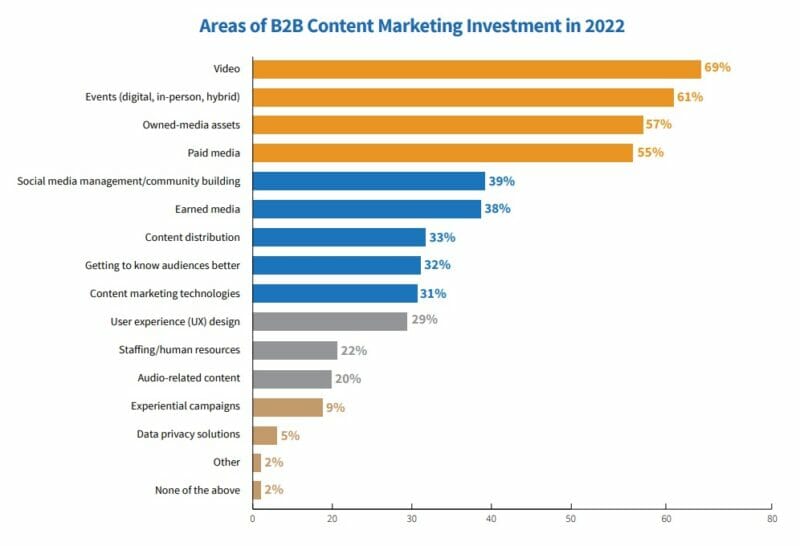

Source: contentmarketinginstitute.com
22. Nearly half of B2B buyers email their order
Email isn’t just used by B2B organizations, but also by their buyers. A survey completed revealed that 45% of B2B buyers email their order. On the other hand only 36% prefer to place orders telephonically.
23. 41% of B2B buyers use email for purchasing decisions
According to MarketingCharts, B2B buyers read 13 content pieces before they make any purchasing decisions. While content plays a key role in the B2B buyer journey, emails don’t feature high up on that list.
Most buyers (70%) looking to invest in marketing tech specifically find that the vendor’s website is the primary source of content. On the other hand, only 41% sourced content from the emails that were sent to them. Third-party sources like internet search, social media, and publications all proved to be more popular than email.


